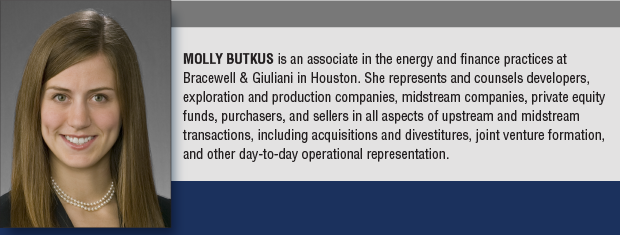
Hedging Strategy
Hedge Monetization Calls For Analysis, Communicating With Lenders
By Trevor Wommack and Molly Butkus
HOUSTON–As observers search for silver linings in what has been described euphemistically as “a dislocated commodity price environment,” perhaps the most tangible upside for many oil and gas producers is the value of their hedge portfolios. Producers who effectively hedged their commodity price risk in summer 2014, when oil prices exceeded $100 a barrel, have seen significant growth to their hedge portfolios’ mark-to-market values. Although commodity prices have recovered somewhat from their February lows, many producers still are looking at a large positive mark-to-market value and are evaluating their strategic alternatives accordingly.
Against this backdrop, we are watching an industry evolve. Declining service costs are allowing producers to develop prospects that otherwise may have been uneconomic. Absent a significant and sustained commodity price recovery, some predict the remainder of 2015 will be characterized by heavy acquisition and divestiture activity, as producers focus on autumn’s borrowing base redeterminations and how potential borrowing base reductions will impact their liquidity needs.
Like any period of volatility, there are risks and opportunities. Producers seeking to capitalize on opportunities should be aware of the legal and business risks of monetizing their hedge positions, but they also need to consider the potential impact to their credit facilities.
Understanding the Hedge
Producers have employed a variety of hedging strategies to protect against commodity price fluctuation. The most common contracts are puts, collars and swaps.
A put is the right to sell a barrel of crude oil at a fixed strike price, which effectively sets a floor price on production. A put will require some form of upfront payment.
A collar is a way to obtain a put’s downside protection while reducing the upfront payment by selling some of the upside. A collar allows the producer to receive the market price within a range and will provide a floor price for downside protection at the lower strike price, but also will cap the price and establish a ceiling at the higher strike price.
Finally, a swap, generally speaking, effectively can guarantee the producer a certain crude price, regardless of whether the market price is higher or lower. Each of these contracts will be limited to a notional volume within a certain time frame.
The common theme in these hedge contracts is the protection they provide, in the form of a payment to the producer, when the commodity market price drops below the hedge’s strike price. Viewed in this light, a hedge portfolio represents a stream of cash flow that fluctuates inversely with commodity prices. Like any source of cash flow, it can be reduced to a present value and–for commonly used hedges–the present, mark-to-market, value can be estimated.
Producers can monetize hedges by terminating the hedge with their counterparty or by restructuring the hedges to reduce the strike price, shorten the tenor or reduce the notional volumes hedged. In evaluating their hedge monetization strategies, producers must consider how hedge monetization will impact their credit facilities, and they should be proactive about communicating their strategy with their lenders to avoid potential pitfalls.
Reserve-Based Loans
Given the important role a hedging program plays for oil and gas producers, it should be expected that an operator’s typical working capital facility will contain a number of covenants and adjustment mechanisms that deal with the borrower’s hedge monetizations.
It is analyzed from the perspective of a traditional working capital revolving credit facility, with availability subject to a borrowing base that is determined according to the borrower’s oil and gas reserves, and commonly is referred to as a reserve-based loan (RBL).
A traditional RBL’s borrowing base is determined by a number of variables from an engineering report that evaluates the borrower’s assets, but the primary variables capital providers consider are the borrower’s projected future production of oil and gas from reserves, the price the production can obtain when it is sold, and any price protection from the borrower’s hedge positions.
In this light, the borrowing base is a function of the discounted net present value of the future cash flow attributable to the borrower’s oil and gas assets and commodity hedges.
Borrowing Base Reductions
A traditional RBL provides for semiannual borrowing base redeterminations, one or more “wildcard” redeterminations that can be requested by either the borrower or lenders, and adjustments or redeterminations contingent on events that include asset sales or hedge position modifications.
Adjusting a borrowing base after an asset sale is intuitive because the borrowing base assumes production from certain assets. If those assets are no longer available, it diminishes production projections and yields a lower net present value of cash flow. For administrative simplicity, the borrower typically is permitted to sell assets up to a certain threshold before there are borrowing base impacts. The specifics vary by credit facility, but a typical adjustment mechanism automatically reduces a borrowing base when the fair market value (or allocated borrowing base) of an oil and gas asset sale exceeds 5 percent of the borrowing base.
A hedge modification’s impact on a borrowing base is structured similarly to an oil and gas asset sale, but the impact is less intuitive. A borrower with no hedges is subject to the banks’ commodity market projections. Hedges that have set a floor price above the bank’s price deck will raise the borrowing base because the projected future cash flow from the borrower’s production exceeds market projections. As such, hedges that have been calculated into a borrowing base are analogous to oil and gas properties that have been figured into borrowing base determinations–both provide cash flow to increase present value.
Although it may not be difficult to appreciate how hedge considerations can influence a borrowing base; any borrowing base adjustment following a hedge monetization is more complicated than one for asset sales. It is common for hedge modifications to share the same 5 percent threshold applicable to asset sales. This raises the question of what value is being measured when lenders determine if a modification meets the adjustment threshold.
Asset sales offer easily ascertainable numbers that are provided by fair market value or the value that is attributed to the properties in the borrowing base. It may seem intuitive that hedges’ mark-to-market value offers a reasonable proxy that corresponds to the fair market value of the oil and gas properties being sold; however, this is rarely the case. The amount by which a hedge monetization impacts the borrowing base often is placed in the discretion of the administrative agent or lenders and is described as the value attributable to those hedges in the borrowing base.
Occasionally, borrowing base reductions following a hedge monetization exceed the hedges’ mark-to-market value. In such cases, a redetermination may trigger a borrowing base deficiency because the cash proceeds from the hedge monetization are insufficient to repay the deficiency. In such a situation, the loan amortizes the deficiency, constraining the borrower’s liquidity. Accordingly, when borrowers consider monetizing hedges, it is incumbent upon them to proactively communicate with their lenders.
EBITDAX Impacts
While the impact of hedge monetizations is felt most directly when a borrowing base shrinks, borrowers and lenders also should be cognizant of potential financial covenant impacts. The typical RBL will include one or more financial covenants based on cash flow, represented by earnings before interest, taxes, depreciation, depletion, amortization and exploration expenses (EBITDAX). The most common covenants are a leverage ratio, calculated as the ratio of debt to EBITDAX and an interest coverage ratio, calculated as EBITDAX to interest expense.
EBITDAX is a metric that is not calculated according to generally accepted accounting principles (GAAP) and is negotiated, often extensively, to be deal-specific. In negotiating EBITDAX, lenders seek a structure that reflects cash flow from operations, rather than gains from sales of capital assets or other nonrecurring revenues; however, many of the market’s EBITDAX definitions were negotiated in a relatively stable or appreciating commodity price environment and may not address issues presented by the growth in mark-to-market value of hedge positions. There are at least three components of revenue from hedges that can be treated differently in financial covenants:
First, EBITDAX typically is structured to negate noncash gains or losses that are associated with fluctuations in a hedge’s mark-to-market value. A hedge’s mark-to-market value fluctuates with the underlying commodity prices and certain accounting rules may require including these paper gains and losses in GAAP revenue calculations. It is common for EBITDAX to negate these effects because they do not represent cash gains or losses.
Second, cash payments the borrower receives from a swap counterparty in the ordinary course of business typically are included in EBITDAX calculations. These payments result from the monthly settlement of the borrower’s hedges and represent a cash payment to the borrower that offsets the decreased price of the borrower’s production sales.
Third, and most importantly for this analysis, is the treatment of nonrecurring cash payments resulting from hedge monetizations.
In a stable commodity price environment, gains from hedge monetizations would not represent a significant amount. However, as hedges’ mark-to-market values have grown significantly alongside falling commodity prices, the potential monetization of those hedge positions may impact EBITDAX significantly. The definition of EBITDAX in credit agreements should be evaluated to determine whether the calculations account for gains from hedge monetizations, and it is advisable to revisit whether this treatment is appropriate in light of recent developments.
There are factors supporting both sides of the argument about whether EBITDAX should include these gains. On one hand, a lump sum payment from a hedge monetization is a nonrecurring gain because it cannot be replicated once the hedge is sold or terminated. As a one-time gain, it may not be appropriate to include it in an EBITDAX calculation. On the other hand, the lump sum payment represents the present value of a cash flow stream that the borrower would have received for the hedge’s duration and therefore may be more akin to cash flow than an asset sale gain.
However, this assumes stable commodity prices during the hedge’s remaining term. If commodity prices increase, cash flow from the hedge decreases proportionately. In that environment, including net gains from hedge monetizations in EBITDAX calculations essentially gives the borrower two figurative bites at the apple: the increased revenue from selling production on the market at the higher price and the gains on a hedge monetization. These factors vary on a case-by-case basis, but regardless of how this is negotiated in a specific deal, the impact will linger for at least four quarters, since EBITDAX generally is measured on a trailing 12-month basis.
Conclusion
With slumping commodity prices, many producers’ hedge portfolios are sporting large mark-to-market values. These hedge positions represent relatively liquid assets that can be monetized strategically to allow producers to capitalize on opportunities. However, before producers embark down this path, they should closely analyze hedge monetization’s impact on their working capital credit facilities.
Communicating proactively with lenders about hedge monetization strategies can facilitate the execution of those strategies and help producers avoid unexpected pitfalls.
For other great articles about exploration, drilling, completions and production, subscribe to The American Oil & Gas Reporter and bookmark www.aogr.com.















